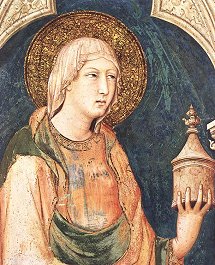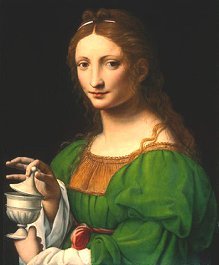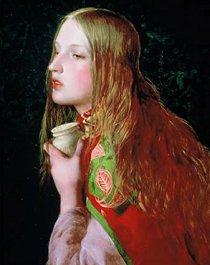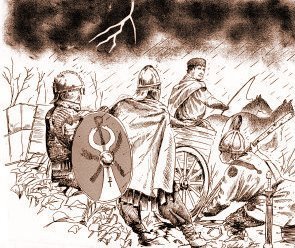Page 2 of 11
The Chalice of Magdalene

The Holy Grail by the nineteenth-century Pre-Raphaelite painter Gabriel Rossetti.
Early Christian tradition holds that Jesus' follower Mary Magdalene collected Christ's blood in a sacred vessel after the Crucifixion. In this version of the story, the vessel is not the cup of the Last Supper, but an oil or ointment container. The Gospels describe how a woman, usually identified as Mary Magdalene, prepared Jesus for his martyrdom by anointing him with spikenard, an aromatic oil or balm, and the vessel she is said to have used to collect Christ’s blood was the jar that had contained this oil. From the early Middle Ages, Mary’s sacred vessel has been depicted by artists as a variety of receptacles, such as spice pots, perfume jars, and ointment cups. The word used in the English translation of the Bible for Mary’s ungent vessel is "box", although the earlier Latin Bible uses the word alabastrum, the Roman name for a container for perfumes or scented oils, so called because they were usually made from alabaster. Such receptacles were fashioned in a variety of shapes and sizes; not only boxes, but also flasks, pots, and jars.
The Holy Grail and the Chalice of Magdalene



For centuries artists have portrayed Mary Magdalene with her sacred vessel, that has been depicted as a variety of receptacles. For example: in 1317 the medieval Italian painter Simone Martini depicted it as a spice pot (above left); in 1525 the Italian Renaissance artist Bernardino Luini depicted it as a perfume jar (center); and in 1859 the English Pre-Raphaelite painter Frederick Sandys depicted it as an ointment cup (right).
Originally called the Marian Chalice, meaning the Chalice of Mary Magdalene, Mary's sacred vessel was believed to have been sealed up in Jesus’ empty tomb where it remained for almost four hundred years. After the Roman emperor Constantine the Great converted to Christianity in the early fourth century, his mother the Empress Helena ordered the excavation of the Holy Sepulchre, the purported site of Christ’s tomb in Jerusalem. During the excavation a cup was found which many believed to be the Marian Chalice. It was taken to Rome where it was believed to possess miraculous healing powers.
The Marian Chalice, or Chalice of Magdalene, remained in Rome until the city was sacked by the barbarians in AD 410. Along with other treasures, it was taken from the city in an armed convoy of carts and brought to the safety of Britain, the last outpost of Roman civilization in Western Europe. What then happened to the sacred relic went unrecorded, but well into the Middle Ages the legend persisted that it was still hidden somewhere in the British Isles. (See also> Holy Relics)

The Chalice of Magdalene leaves Rome. Illustration by Dan Shadrake.








